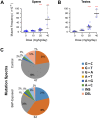In Utero Exposure to Benzo[a]Pyrene Increases Mutation Burden in the Soma and Sperm of Adult Mice
- PMID: 27448386
- PMCID: PMC5226697
- DOI: 10.1289/EHP211
In Utero Exposure to Benzo[a]Pyrene Increases Mutation Burden in the Soma and Sperm of Adult Mice
Abstract
Background: Mosaicism, the presence of genetically distinct cell populations within an organism, has emerged as an important contributor to disease. Mutational events occurring during embryonic development can cause mosaicism in any tissue, but the influence of environmental factors on levels of mosaicism is unclear.
Objectives: We investigated whether in utero exposure to the widespread environmental mutagen benzo[a]pyrene (BaP) has an impact on the burden and distribution of mutations in adult mice.
Methods: We used the Muta™Mouse transgenic rodent model to quantify and characterize mutations in the offspring of pregnant mice exposed to BaP during postconception days 7 through 16, covering the major period of organogenesis in mice. Next-generation DNA sequencing was then used to determine the spectrum of mutations induced in adult mice that were exposed to BaP during fetal development.
Results: Mutation frequency was significantly increased in the bone marrow, liver, brain, and sperm of first filial generation (F1) males. Developing embryos accumulated more mutations and exhibited higher proportions of mosaicism than exposed adults, particularly in the brain. Decreased sperm count and motility revealed additional negative impacts on the reproductive function of F1 males.
Conclusion: In utero exposure to environmental mutagens contributes to somatic and germline mosaicism, permanently affecting both the genetic health of the F1 and the population gene pool. Citation: Meier MJ, O'Brien JM, Beal MA, Allan B, Yauk CL, Marchetti F. 2017. In utero exposure to benzo[a]pyrene increases mutation burden in the soma and sperm of adult mice. Environ Health Perspect 125:82-88; http://dx.doi.org/10.1289/EHP211.
Conflict of interest statement
The authors declare they have no actual or potential competing financial interests.
Figures




References
Publication types
MeSH terms
Substances
Grants and funding
LinkOut - more resources
Full Text Sources
Other Literature Sources

